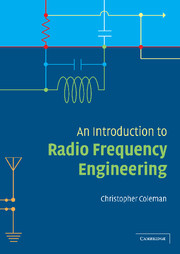Book contents
- Frontmatter
- Contents
- List of figures
- Preface
- Acknowledgements
- 1 Basic concepts
- 2 Frequency selective circuits and matching
- 3 Active devices and amplifiers
- 4 Mixers, modulators and demodulators
- 5 Oscillators and phase locked loops
- 6 Transmission lines and scattering matrices
- 7 Power amplifiers
- 8 Filters
- 9 Electromagnetic waves
- 10 Antennas
- 11 Propagation
- 12 Digital techniques in radio
- Index
12 - Digital techniques in radio
Published online by Cambridge University Press: 05 June 2012
- Frontmatter
- Contents
- List of figures
- Preface
- Acknowledgements
- 1 Basic concepts
- 2 Frequency selective circuits and matching
- 3 Active devices and amplifiers
- 4 Mixers, modulators and demodulators
- 5 Oscillators and phase locked loops
- 6 Transmission lines and scattering matrices
- 7 Power amplifiers
- 8 Filters
- 9 Electromagnetic waves
- 10 Antennas
- 11 Propagation
- 12 Digital techniques in radio
- Index
Summary
The advent of high speed computers has opened up a whole new range of possibilities for radio. If the RF signal can be adequately represented by a series of samples (at a rate that a computer can handle), standard operations such as mixing, filtering, signal synthesis and demodulation can all be handled as mathematical operations within the computer. Constructing systems that can handle the complex signal processing required by spread spectrum communications, radar and other more exotic RF systems is merely an exercise in computer programming. Since most of the processing will be done inside a computer, we have what is commonly termed software radio. Such radios can be extremely flexible and be instantaneously reconfigured to handle new forms of modulation and/or tasking. All we need is a suitable analogue-to-digital converter (ADC) to interface to the incoming analogue signal and a suitable digital-to-analogue converter (DAC) to produce the outgoing analogue signal. Obviously, any realistic implementation of software radio will involve many constraints, and issues such as sampling rate and quantisation error will need to be addressed. The following chapter introduces the basic ideas of digital RF techniques and their limitations.
The processing of digitised signals
We have already noted the utility of studying RF systems in terms of the complex signal exp(j2π ft). Since cos(θ) = ½ [exp(jθ) + exp(−jθ)], it is clear that the real signal s(t) = S cos(2π ft) will contain, in equal parts, contributions from frequencies f and − f.
- Type
- Chapter
- Information
- An Introduction to Radio Frequency Engineering , pp. 293 - 306Publisher: Cambridge University PressPrint publication year: 2004



